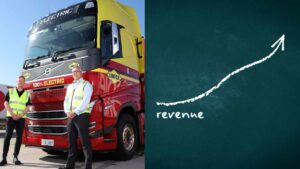Struggling to keep up with your fleet’s day-to-day operations? Fleet management software might just be the magic wand you need.
Whether you are in charge of a small fleet or overseeing a large-scale logistics business, software for fleet management gives you the power to better control your vehicles.
It also helps fleet managers monitor and optimize every aspect of their vehicles and drivers. Best of all, it’s all managed from one central platform.
Maybe you have been doing your operational planning manually, trying to track your vehicles in real time, planning efficient routes, and maintaining the fleet down to the last detail.
Manual planning is a time-consuming administrative task that can be outsourced to increase productivity drastically.
Technology can make your life easier, ensuring you focus on more important parts of running the business.
Whether you want to trim down your fuel expenses, ensure your drivers’ safety, or simply get things running smoothly, this article will answer all your questions.
What is fleet management?
Managing a fleet of vehicles might sound like a logistical headache, but fleet management software makes it way easier than you think.
You want to make sure your logistics operations are run like a well-oiled machine.
Good fleet management can help you cut down on maintenance costs, fuel costs, and road time. It makes sure you keep to a regular routine maintenance schedule, plan the most efficient routes for deliveries, and manage vehicles’ fuel consumption.
What is fleet management software used for?
A solid fleet management system is almost like the backbone of your business. It keeps your operations running smoothly and boosts customer satisfaction. As a result, deliveries arrive on time and in the right delivery window.
Steve Orenstein, CEO and founder of delivery software service Locate2u says this software can address the many concerns fleet managers may have.
“You might have different vehicles inside of your business, and you want to keep track of everything that’s happening in them. If you want to track the GPS location of the vehicle, you might also want to understand how that vehicle has been driven.
“Is the driver turning around the corners in a hard way? You maybe want to measure harsh braking or whether they are idling for long periods of time.”
4 Main benefits of fleet vehicle management
- GPS tracking to track vehicles’ locations in real time.
- Route optimization helps to choose the shortest or best route to reduce fuel consumption and travel time.
- Driver monitoring ensures vehicles are safe while on the road and drivers are complying with rules.
- Maintenance scheduling helps to minimize the downtime when vehicles are in for repairs.
This software is a must-have solution for businesses that rely on vehicles for deliveries, from small vans to long-haul trucks. Using this technology, a company can monitor their vehicles from a desktop or mobile application.
Key features of fleet management solutions
Most fleet management systems have three components: A hardware device to track each vehicle, a mobile app for drivers to use, and desktop software for managers to track vehicles, schedules, and dispatch cars.

Fleet management software helps to make it easier to manage different types and sizes of vehicle fleets. Here are some of the key features that make this software indispensable for businesses.
Vehicle tracking
Vehicle tracking is one of the most important features of fleet management software. It uses GPS technology, allowing fleet managers to monitor the real-time location of their vehicles.
Some software also offers geofencing, a virtual fence around a physical location perimeter around a physical location. It sends alerts if a vehicle passes certain geographic boundaries you’ve set up. Tech Co says this helps to deter vehicle misuse and theft.
Vehicle tracking is crucial for optimizing routes, reducing fuel consumption, and ensuring that drivers are accountable.

Most fleet management software provides a comprehensive map view, enabling managers to track vehicle movements and receive alerts for any unusual activities. This not only enhances operational efficiency but also improves overall fleet security.
Vehicle health and reminders
I bet you dread the days when vehicles are no longer reliable. It means fewer deliveries and less productivity. But maintaining the health of your fleet can just make your life easier. It reduces the downtime and extends the vehicle lifespan.
Fleet management software offers robust vehicle health monitoring and maintenance reminders. Fleet managers can set up alerts for routine maintenance tasks, track the condition of each vehicle, and receive notifications for any potential issues.
By proactively managing vehicle health, businesses can reduce unexpected breakdowns, improve safety, and ensure that their fleet operates at peak efficiency.
Cost control and reports
Everyone wants to save costs and increase productivity. Cost control is a critical aspect of fleet management.
Cost control lets you keep track of operational expenses:
- Fuel consumption
- Maintenance expenses
- Overall operational costs
Fleet managers can analyze these reports to identify inefficiencies and make data-driven decisions to reduce expenses.
By closely monitoring fuel costs, vehicle abuse, and driver behavior, businesses can implement strategies to improve and save money.
By leveraging these key features, fleet management software empowers businesses to manage their fleets more effectively, ensuring that they operate smoothly, efficiently, and cost-effectively.
Types of fleet management software
Fleet management software comes in many forms, each designed to solve different business needs. The main types include:
- GPS tracking: Basic systems that provide real-time vehicle location data. This GPS tracking software knows exactly where the assets are at all times.
- Telematics systems: These offer more advanced features, like tracking driver behavior, fuel usage, and maintenance needs.
- Fleet maintenance software: Focused on keeping vehicles operational by managing service schedules, part replacements, and inspections.
- Integrated fleet management software: These all-in-one solutions often integrate with ERP, CRM, and accounting systems for end-to-end visibility and control over fleet operations.
Choosing the right fleet management software for your business requires good research and comparisons. Make sure you look at customer reviews.

Benefits of using fleet management software to reduce fuel costs
The advantages of fleet management software go far beyond just keeping an eye on your vehicles. Let’s go into detail now how a business benefits from using the best fleet management software.
Let’s break it down:
- Optimized routes, lower costs: Advanced software analyzes real-time data (think traffic, road closures, and driver performance) to craft the most efficient routes. This not only trims fuel expenses but also reduces wear and tear on vehicles.
According to Juan Cardona, vice president of sales at Geotab, businesses that use fleet management software save significantly in fuel costs. “The return on telematics is quite immediate, maybe about a month. Fleet managers could see 15 to 20% savings on their costs. With this, they can invest in other things for their employees.”
- Total visibility: With GPS tracking and data from telematics devices, you get a 360-degree view of your operations, from vehicle locations to driver habits. That’s more informed decision-making, less downtime, and better customer service.
- Safety first: Monitoring driver behavior in real-time helps flag risky actions like speeding or harsh braking. Studies by Fleet Complete show that businesses using fleet software see a 10-15% reduction in accidents and insurance costs.
- Enhanced compliance: Automated tracking of hours-of-service and vehicle maintenance helps businesses stay compliant with local laws and avoid fines.
- Better customer service: With real-time tracking and faster response times, customer satisfaction improves.
Common challenges fleet managers face
Managing a fleet comes with its own set of hurdles. Here are the top challenges and how fleet management software turns them into opportunities:
- Lack of visibility: Without knowing exactly where your vehicles are or how they’re performing, inefficiencies and high costs sneak in. Fleet management software gives you real-time tracking and insights, helping you act fast and smart.
- Compliance headaches: Staying compliant with ever-evolving regulations (think maintenance, inspections, driver hours) is overwhelming. But with automated reminders and compliance tracking, software keeps you ahead of the game.
- High fuel costs: Fuel is a major expense for fleet managers. According to the U.S. Energy Information Administration (EIA), fuel prices increased more than 30% between 2020 and 2021. Fleet software helps combat this by optimizing fuel usage and highlighting wasteful driving behaviors like idling.
How fleet management software boosts efficiency
Efficiency is key in fleet management. You want to ensure that your customers get the best service they deserve.
Using fleet management tools like route optimization and real-time tracking can boost your delivery time and reduce fuel costs.

Here’s how software takes productivity to the next level:
Route optimization
Route optimization takes into account traffic, road closures, and driver performance. It can reduce time on the road and minimize overall costs.
Better driver behavior
By tracking metrics like harsh braking, speeding, and idling, the software can provide feedback that encourages safer, more efficient driving.

Automated maintenance
Stay ahead of breakdowns with scheduled maintenance alerts. Fleet software keeps your vehicles in top shape by automating these tasks. As much as 40% of an organization’s operational budget can be spent on poorly managed maintenance schedules.
Choosing the right fleet management solution
Selecting the best fleet management software depends on your business’s size, type of fleet, and specific challenges. There are three main factors to consider: fleet size and needs.
Size of your fleet: Larger fleets need robust solutions with advanced features like telematics and in-depth reporting, while smaller fleets may benefit from simpler, more cost-effective options.
Specific needs: Whether you manage long-haul trucks or last-mile delivery vans. Each type of operation has unique challenges, so it’s essential to choose software that addresses those specific needs.
Implementing software to manage fleet
Implementing fleet management software is about more than just clicking “install.” You want to retrieve personalized data, develop a strategy to improve these pain points and train your staff to ensure the company’s success.
Firstly, you assess your current processes.
Where are your pain points? Whether it’s route planning or compliance, knowing what needs improvement will help you select the right software.
Secondly, you develop a plan.
Set clear goals, gather your stakeholders, and outline a timeline for rolling out the new system.
Thirdly, you train your team.
Fleet management software is only as good as the people using it. Offer comprehensive training and designate a “software champion” who can answer questions and ensure the team stays on track.
Fleet management software price
Now, let’s discuss the cost of fleet management software. It all depends on the size of your fleet and the features you need. But we can work on average to give you a better idea of what you can bargain for with your budget.
Remember, costs are always negotiable.
Small fleets (under ten vehicles): Expect to pay around $15-35 per vehicle per month. Basic plans usually include GPS tracking and route optimization.
Medium fleets (10-50 vehicles): Plans can range from $25-50 per vehicle per month, often with added features like driver safety monitoring and compliance tracking.
Large fleets (50+ vehicles): Costs can reach $70+ per vehicle per month, depending on the level of customization, analytics, and integration capabilities.
The future of car fleet software
Fleet management software is evolving quickly. You have autonomous vehicles (AV), electric vehicles (EV), and even augmented reality (AR) for vehicle maintenance.
The Canadian software company Bright Order says the impact of AVs is far more than saving costs and streamlining operations. It also has the benefit of cutting labor costs and making deliveries more human error-free.
Fleet management software is adapting to handle the unique demands of AVs, offering even more precise control and oversight.
EVs now account for 16% of all new car sales in Europe. It’s driven by environmental concerns and long-term cost savings. Software solutions are evolving to manage the specific needs of EV fleets, such as battery life monitoring, charging station integration, and emissions tracking.
AR is finding a place in vehicle maintenance, making fleet management software a central hub for more efficient and accurate repairs. With AR, mechanics can visualize components and diagnose issues faster, reducing downtime and keeping vehicles on the road longer.
The next step in your journey to manage your fleet
Fleet management software is more than a tool—it’s the key to unlocking smoother, safer, and more efficient operations.
By choosing the right software, like Locate2u, and making the most of its features, you can differentiate yourself from your competitors.
About the author
Mia is a multi-award-winning journalist. She has more than 14 years of experience in mainstream media. She's covered many historic moments that happened in Africa and internationally. She has a strong focus on human interest stories, to bring her readers and viewers closer to the topics at hand.













